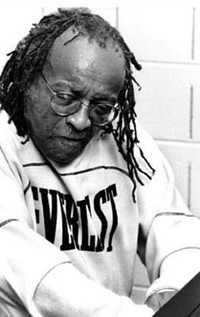Cecil Taylor
New York NY, 16 February 2005
by James Beaudreau
25 April 2005
 Regular readers of One Final Note might remember my last Cecil Taylor review of about a year ago. When notice came around that Taylor was due back at the Iridium with the same format (big band), I was tempted to go back and see what might have or might not have changed. But it turns out that for the first night of the engagement the pianist was appearing with a trio, and I couldn’t resist seeing him in a preferred setting. Regular readers of One Final Note might remember my last Cecil Taylor review of about a year ago. When notice came around that Taylor was due back at the Iridium with the same format (big band), I was tempted to go back and see what might have or might not have changed. But it turns out that for the first night of the engagement the pianist was appearing with a trio, and I couldn’t resist seeing him in a preferred setting.
My visit to the Iridium, I should say, was more pleasant than last time. Mostly due to a lack of anything particularly unpleasant, which is good enough when it comes to the big-name NYC clubs. The staff was friendly and courteous, even under pressure. It was a packed house. They had to pull folding tables out and place them on a slanted passage near the bathrooms for a quartet of unlucky, but seemingly stout tourists, who were required to keep a nervous eye on their 30-degree drinks throughout the set. Taylor was looking pretty sharp in an untucked, white-collared powder blue shirt. It’s informative to see him live: his physicality presents a key to a certain way to listen to him. One thing that records have over live performances is that they direct listening less. For example, on record, it is possible to imagine Taylor sitting at the piano, rock solid in the middle, executing his music from his mind: cool, detached, and theoretical. And listening that way, the notes themselves have more meaning—they’re all one has to go on. But when you see Taylor live, you see that it’s not about the notes. He’s more like a shaman battling unruly forces. As soon as one sound is made, the game is on. Light and shade, power and receptivity—all opposites are in constant play against the other, and it’s his job to deal with them. At times, the pianist looks like he’s smoothing out sheets from the center of the keyboard, digging down into the middle of it and sending ripples off the extreme registers. Other times he chooses particular trouble spots to cast arcane digital spells or knead like dough. Then he rolls his hand over to brush the keys with knuckles, with tenderness, like he’s petting a cat. Taylor was accompanied by Albey Balgochian, self-styled “avant-garde funk bassist”, and regular drummer Jackson Krall. Balgochian, with his skeletal upright electric instrument, was set between the drummer and pianist as if to break up a fight should one break out. He appeared in what I took to be Japanese garb, and ponytail. Krall was in cool, collarless black. The set began with sounds like leaves falling, or some such quiet stirrings: the kind of audible incense that Taylor typically uses to clear the space. Krall, who has a spreading, multi-directional sense of time, looked to be at the absolute cusp of the instant, responding to Taylor with infinitesimal sensitivity and with a capability to change direction at a split-second. You can see it in how he approaches his instrument: sometimes moving toward a cymbal only to hesitate once or twice, in motions as small as twitching, before landing a stroke. There are thousands and thousands of such events in his playing. And he’s been playing with Taylor long enough to know how to comment on, and expand the pianist’s figures. Balgochian, on the other hand, stood somewhat like a swordfighter between them, threading his groove-seeking bass through the dense systems of his partners. But it fell apart after not too long. I don’t know what happened, but a quarter of an hour into the set, communication lines went down. Krall seemed only to react to Taylor and not direct the music at all, and Taylor seemed unchallenged, as if he were playing in a vacuum. As good as Krall is, and he’s very good indeed, he seems not to want to engage the pianist, only support him. Once the Krall-Taylor energy fell apart, it seems that Balgochian was left to fend for himself, and he went off into his own world. This state was particularly evident in the second long piece when I observed that the temperature of the rest of the audience seemed to have fallen too. Sparks were rekindled toward the end of the set, but no fires were started. Probably the best Taylor I’ve seen live was with Max Roach, a concert I mentioned in my last review. Roach was at all times conversational, and though not argumentative, certainly engaging. There were moments where he seemed to be playing longer and longer, upsetting expectations of endings, as the pianist himself sometimes does. And this seemed to bring the best out of his partner. Perhaps this trio’s focus resumed in the second set—I can’t say, as I didn’t witness it. But it looked like the event was being recorded, so perhaps we’ll get to find out.
|

